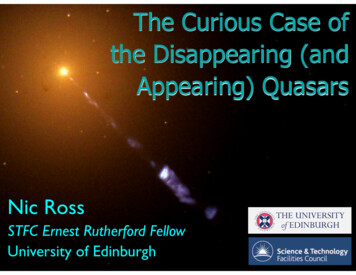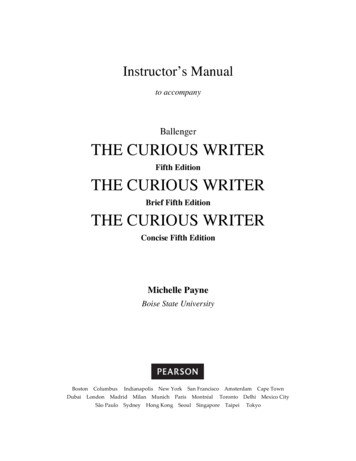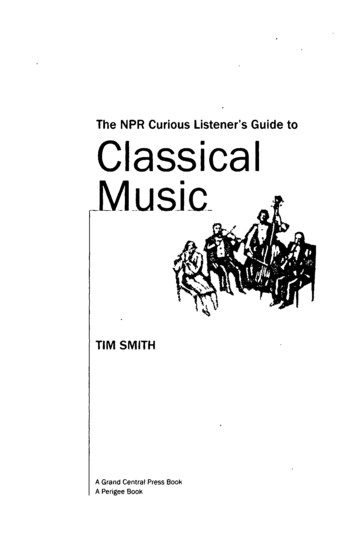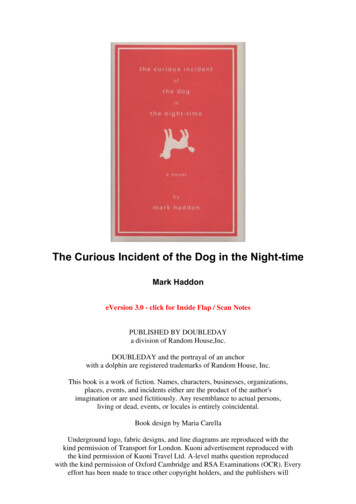
Transcription
The Curious Case ofthe Disappearing (andAppearing) QuasarsNic RossSTFC Ernest Rutherford FellowUniversity of Edinburgh
The Curious Case ofthe Disappearing (andAppearing) QuasarsChelsea Macleod, NPR, Andy Lawrence et al.2016, MNRAS, 457, 389“A Systematic Search for Changing Look Quasars in SDSS”
Why you (LBNL) care? BOSS, eBOSS, DESI all have QSOs as LSS/BAO tracers:Luminosity (in)dependent bias of QSOs AGN in DESI ELGs (# same as DESI QSOs) QSOs as Standard Candles:1. via Reverberation Mapping(e.g. Watson et al., 2014; King et al. 2014, 2015; Shen et al.2015; Yuan et al., 2015)2. via log LUV - LX relation (e.g. Risaliti & Lusso, 2015) Uses BOSS data(over 210 cites to the BOSS QSO catalogues)
Hopkins et al. 2008, ApJS, 175, 356
PLEASE STOP USING THIS!!!THERE’S INCREDIBLYLITTLE OBSERVATIONALEVIDENCE THIS IS THEGENERAL CASE FORz x QSOs!!!!(where x 0)Hopkins et al. 2008, ApJS, 175, 356
To add more context than just the slides, the “majormerger” hypothesis is a (very) viable idea for the mostluminous quasars at the bright(est) end of the quasarluminosity function. However, at the “knee” of theluminosity function, where the most BH mass build-uphappens, it is (very) unclear what the main mechanism forBH growth.As such, and with very little evidence for major mergerspowering quasars at z 0, this motivational cartoon has tocurrently be taken with large pinch of salt.
The “AGN UnificationModel”
The “AGN UnificationModel”ALSO PLEASE THINKBEFORE USING THIS!!!THERE’S NOT MUCHOBSERVATIONALEVIDENCE THIS IS THEGENERAL CASE FORz x QSOs!!!!(where x 1)
The “AGN UnificationModel”ALSO PLEASE THINKBEFORE USING THIS!!!THERE’S NOT MUCHOBSERVATIONALEVIDENCE THIS IS THEGENERAL CASE FORz x QSOs!!!!(where x 1)Basically at odds with“major merger”scenarioNetzer2015, ARAA, 53, 365“Revisiting the Unifiedmodel of ActiveGalactic Nuclei”
Again, to add more context than just the slides, the “AGNUnification Picture”, is a very good starting point forexplaining the range in AGN observed properties.However, a major outstanding issue is whether these AGN/Quasars follow an “evolution” (as given in the Hopkins etal. slide) or “orientation” paradigm.There are fundamental issues still at large with the‘orientation’ paradigm, such as the stability and geometry ofthe obscuring medium, the timescales associated with themany physical processess involved, the “classic problem” ofthe lack of high-luminosity, high-obscuration objects at z 1,and of course the precise nature of the Broad Line Region.This talk and work begins to directly address this last issue.
Quasar SpectraBroad Emission Lines( 2000 km s-1)Blue Continuum Slope(from accretion disk)“Type 1”HβVanden Berk et al.2001, AJ, 122, 549
Why we care about CLQs“Changing Look Quasars” (CLQs) are defined to be luminous AGNwhich are observed to have a dramatic appearance, ordisappearance, of their broad emission-line (BEL) component.CLQs offer a direct probe into the physical processes dictating thestructure of the AGN broad-line region (BLR), and do so on yeartimescales.These timescales can potentially be associated with: the viscous timescale (associated with radial drift timethrough the accretion disk), the light crossing timescale (critical for reverberationmapping and disk reprocessing) and the dynamical timescale of the BLR.
CLQ “History” Appearing Broadlines Markarian 6 (z 0.018 Mi -20.3; Khachikian & Weedman1971) Vanishing Broadlines NGC 7603 (z 0.0295, Mi -21.7 Tohlin & Osterbrock 1976) First Changing Look “Quasar” SDSS J0159 0033 (z 0.31, Mi -22.7 in SDSS Quasarcatalog, Mi -22.0; LaMassa et al. 2015) First systematic’ (a.k.a. non-serendipitous) search Macleod, NPR et al. (2016; z 0.20-0.62).
Sample Selection of CLQ Candidates SDSS DR7Q: Mi -22, both point sources and resolvedobjects (Schneider et al. 2010) Δg 1.0 mag among any observations in SDSS and PS-1
Sample Selection of CLQ Candidates SDSS DR7Q: Mi -22, both point sources and resolvedobjects (Schneider et al. 2010) Δg 1.0 mag among any observations in SDSS and PS-1 6348 DR7Q objects have Δg 1.0 mag We do not consider 3 blazars, radio sources with 2-3 mag changes overmonths; see e.g. Ruan et al. 2012.
Sample Selection of CLQ Candidates
Sample Selection of CLQ Candidates
Sample Selection of CLQ Candidates SDSS DR7Q: Mi -22, both point sources and resolvedobjects (Schneider et al. 2010) Δg 1.0 mag among any observations in SDSS and PS-1 6348 DR7Q objects have Δg 1.0 mag We do not consider 3 blazars, radio sources with 2-3 mag changes overmonths; see e.g. Ruan et al. 2012.
Discovery of 10 CLQs
Redshift and Luminosity
Redshift and Luminosity
Results (1/5) BEL (dis)appearance associated with large changesin continuum flux. 4 with emerging BELs 5 with disappearing BELs One with both emerging and vanishing BELs Simple obscuration cannot account for BEL changes Timescales shorter than expected for accretion ratechanges in the optical emitting region
Results (2/5) BEL (dis)appearance associated with large changesin continuum flux. 4 with emerging BELs 5 with disappearing BELs One with both emerging and vanishing BELs Simple obscuration cannot account for BEL changes Timescales shorter than expected for accretion ratechanges in the optical emitting region
Results (3/5) BEL (dis)appearance associated with large changesin continuum flux. 4 with emerging BELs 5 with disappearing BELs One with both emerging and vanishing BELs Simple obscuration cannot account for BEL changes Timescales shorter than expected for accretion ratechanges in the optical emitting region
Results (4/5) BEL (dis)appearance associated with large changesin continuum flux. 4 with emerging BELs 5 with disappearing BELs One with both emerging and vanishing BELs Simple obscuration cannot account for BEL changes Timescales shorter than expected for accretion ratechanges in the optical emitting region
Results (5/5) BEL (dis)appearance associated with large changesin continuum flux. 4 with emerging BELs 5 with disappearing BELs One with both emerging and vanishing BELs Simple obscuration cannot account for BEL changes Timescales shorter than expected for accretion ratechanges in the optical emitting region“ 15% of strongly variableluminous quasars displaychanging-look BEL featureson rest-frame time-scales of8-10 years. ”
(Very low level) Interpretation “Difference spectra” consistent with fν ν1/3 suggestingvariable component has an SED similar to an accretiondisk Simple dust obscuration models (e.g. MW, SMC) ruledout Light Curves and narrow emission not consistent withTidal Disruption Events (TDE short, sharp event) Light Curves not consistent with e.g. (clumps of) dustcrossing timescales (tcross, dust OoM too long) Potentially due to change in accretion rates; but needssome thought into e.g. “disc reprocessing” mechanisms
Next Steps and Conclusions Light curve analysis plus spectroscopy very powerfultool; very efficient at finding CLQs. 10 (9) objects out of 6350 (99) with Δg 1.0 mag (and Δt 1000 days) are CLQs Potentially due to change in accretion rates; but needssome thought into e.g. “disc reprocessing” mechanisms WHT time in 2016A,B and Long-Term Status; justfinished first run, with first new CLQ discovered at theweekend!! TDSS, DESI, “After Sloan 4” etc. will clean up BH Major merger rates. ;-)
Chelsea Macleod, NPR, Andy Lawrence et al. 2016, MNRAS, 457, 389 “A Systematic Search for Changing Look Quasars in SDSS” T











